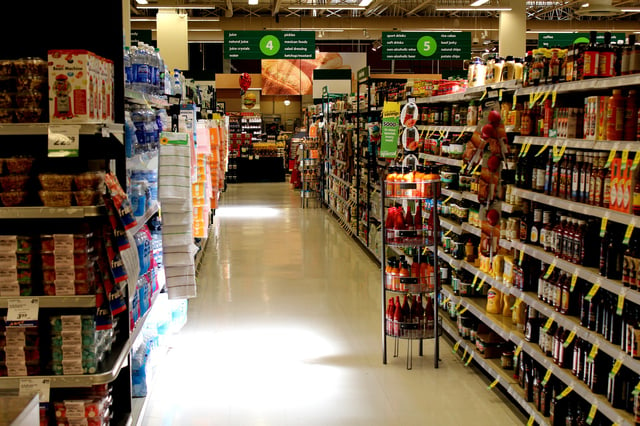An effective product pitch is essential to any brand marketing strategy.
For emerging food and beverage brands, making the leap to grocery store shelves can be an intimidating yet incredibly necessary step for their product. Getting into supermarket aisles significantly widens a brand's potential consumer base and exponentially increases its potential revenue haul. But there's more to earning that coveted shelf space than many merchandisers realize, which leaves some merchandisers woefully unprepared when it comes time to make a pitch to grocery stores about their product.
To successfully impress retailers and leave them clamoring to get your product on their shelves after a pitch, you need to research each retailer and their typical consumers, corner a niche to make your product stand out from others like it, and align your product with a retailer's business goals.
Utilize these strategies to wow retailers and get your product in grocery stores in no time:
Make Your Product Stand Out
You might have researched everything there is to know about a retailer, but it won't mean anything if you're selling something they already have. Before going into a pitch meeting, you need to think about how your product is different from others like it. It's a smart idea to target a specific angle in your pitch - such as health, price or ingredients - and emphasize to retailers how your brand will stand out from other products in your industry.
For example, Revolution Foods is attempting to reinvent the packaged meal industry through its innovative packaging design. Although Revolution Foods's products are similar to well-known brands such as Hamburger Helper and Lunchables, Revolution Foods is pitching its brand as the healthier alternative to these staples of the industry, which are high in fat and sodium, according to Fortune. With this strategy, the brand aims to make headway in an industry that hasn't changed much over the years.
"A lot of the brands that were popular when I was a kid are still popular today," Steve Case, an investor in Revolution Foods, told Fortune. Brand executives hope to stir excitement in consumers about Revolution Foods and drive them to a type of product that has faced declining sales in recent years, the source noted.
Take a hint from Revolution Foods and make sure you can convey how your brand will impact the market before you speak to grocery store retailers.
Know Your Audience
One of the biggest mistakes you can make is to go into every pitch with the same strategy you always use. Before each conversation with a retailer, you should research everything about them you can find. This means understanding who a retailer's target consumer base is, having an appropriate price point for that store's consumers and having a grasp on demand for products like yours. Your research should dictate the price point of your product, the type of packaging you should be using, and the marketing strategy you should utilize when making your pitch to a retailer.

Prepare For Slotting Fees
It's also critical for you to understand logistical matters, like how much an individual retailer charges for slotting fees for shelf space at its store. This is particularly important for smaller, emerging businesses that are looking to increase their brand awareness, as these companies often have a hard time paying slotting fees. Going into a pitch, you need a strategy that will convince retailers to put your product on their shelves while staying within your marketing budget. If slotting fees are too expensive to get your product in every store, a savvy tactic is to suggest putting your product through a trial run at a few stores to see how it sells.
Until you have established more brand awareness, you might consider only pitching to retailers that do not require slotting fees for shelf space. Perhaps surprisingly, many big-name retailers such as Wal-Mart, Costco, Whole Foods and BJ's Wholesale don't charge slotting fees, according to Vox. This gives fledgling brands a chance to attract the consumers of larger retailers throughout the country. By demonstrating your knowledge of a retailer's consumers and general marketing strategy, you can make an impression during your pitch and significantly increase your chances of getting into a store.
Help Stores Reach Their Goals
Instead of making a sales pitch only about your product, you should position yourself as a potential teammate to retailers. To do this, you need to familiarize yourself with a business' short-term and long-term goals, and this tactic can go well beyond making a profit. For example, retailers might be looking to expand their offering of healthy or local food options, so marketing your product as a way for retailers to achieve that goal would serve you well during a pitch. It's also smart to bring marketing strategies for your product to the table so retailers have a better idea of how to ensure your product will fly off the shelf.
You should consider how your product could be cross merchandised with other inventory, mock up interesting merchandising displays, and flesh out an advertising strategy before your pitch meeting so retailers are able to see the full potential of having your product in their stores. The more they see you as a partner who wants to work with them, the better your chances are of securing some of the coveted shelf space in one of their retail aisles.
It's critical to keep these strategies in mind while devising your retail pitches. If you follow these guidelines, you'll have the opportunity to position your brand ahead of the competition as you see your products picked up in more and more stores.



.png?width=480&height=252&name=PRESS%20RELEASE-2%20(4).png)

